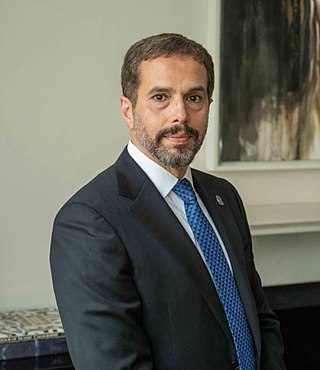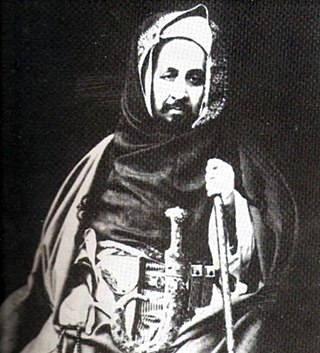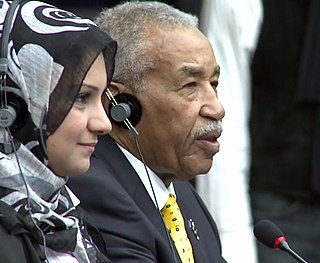
The Senusiyya, Senussi or Sanusi are a Muslim political-religious Sufi order and clan in Libya and surrounding regions founded in Mecca in 1837 by the Grand Sanussi, the Algerian Muhammad ibn Ali al-Sanusi.

Muhammad Idris bin Muhammad al-Mahdi as-Senussi was a Libyan political and religious leader who was King of Libya from 24 December 1951 until his ouster in the 1 September 1969 coup d'état. He ruled over the United Kingdom of Libya from 1951 to 1963, after which the country became known as simply the Kingdom of Libya. Idris had served as Emir of Cyrenaica and Tripolitania from the 1920s until 1951. He was the chief of the Senussi Muslim order.

Sayyid Hasan ar-Rida al-Mahdi as-Senussi was the Crown Prince of the Kingdom of Libya from 26 October 1956 to 1 September 1969, when the Libyan coup d'état resulted in the monarchy being abolished.

The Italian colonizationof Libya began in 1911 and it lasted until 1943. The country, which was previously an Ottoman possession, was occupied by Italy in 1911 after the Italo-Turkish War, which resulted in the establishment of two colonies: Italian Tripolitania and Italian Cyrenaica. In 1934, the two colonies were merged into one colony which was named the colony of Italian Libya. In 1937, this colony was divided into four provinces, and in 1939, the coastal provinces became a part of metropolitan Italy as the Fourth Shore. The colonization lasted until Libya's occupation by Allied forces in 1943, but it was not until the 1947 Paris Peace Treaty that Italy officially renounced all of its claims to Libya's territory.

Mohammed El Senussi is the son of Crown Prince Hasan as-Senussi of Libya, and of Crown Princess Fawzia bint Tahir Bakeer. Born in Tripoli, he is considered by Libyan royalists to be the legitimate heir to the Senussi Crown of Libya.

Hussein Yousef Maziq a Libyan politician was Prime Minister of Libya from 20 March 1965 to 2 July 1967. He was one of the most important men in the Kingdom era of Libya.

Muhammad ibn Ali as-Senussi (1787–1859) was an Algerian Muslim theologian and leader who founded the Senussi mystical order in 1837. His militant mystical movement proved very significant and helped Libya to win its freedom from Italy on 10 February 1947. Omar Mukhtar was one of the most significant leaders of the Senussi military campaign launched by Muhammad ibn Ali as-Senussi. Al-Sanūsī's grandson Idrīs I ruled as king of Libya from 1951 to 1969.

The Kingdom of Libya, known as the United Kingdom of Libya from 1951 to 1963, was a constitutional monarchy in North Africa that came into existence upon independence on 24 December 1951 and lasted until a bloodless coup d'état on 1 September 1969. The coup, led by Muammar Gaddafi, overthrew King Idris and established the Libyan Arab Republic.

Ahmed Sharif as-Senussi was the supreme leader of the Senussi order (1902–1933), although his leadership in the years 1917–1933 could be considered nominal. His daughter, Fatimah el-Sharif was the Queen consort of King Idris I of Libya.

The 1951 Libyan Constitution was brought into force on 7 October 1951, prior to Libya's formal declaration of its independence on 21 December 1951 as a constitutional and hereditary monarchy under King Idris. The enactment of the Libyan Constitution was significant in that it was the first and only piece of legislation that formally entrenched the rights of Libyan citizens after the post-war creation of the Libyan nation state.

During the early stages of the Libyan Civil War of 2011, the Gaddafi regime was still in power: but there was widespread withdrawal of support from that regime by influential persons and organisations within the country. Among those who no longer supported the regime, the main concern they expressed was what they regarded as its use of excessive force against peaceful protestors. There were many resignations by ministers of the governing council and other senior officials, diplomats posted abroad, and senior military officers. Islamic clerics, tribal leaders, and members of the former royal family expressed their opposition, while the two leading Libyan oil companies also withdrew support for the regime.
Abdullah Senussi is a Libyan national who was the intelligence chief and brother-in-law of Colonel Muammar Gaddafi. He was married to Gaddafi's sister-in-law.

Prince Ahmed Al-Zubair al-Senussi, also known as Zubeir Ahmed El-Sharif is a Libyan member of the Senussi house and a member of the National Transitional Council representing political prisoners.

The Libyan Armed Forces or the Libyan Arab Armed Forces are, in principle, the state organisation responsible for the military defence of Libya, including ground, air and naval forces.

Libyan nationalism refers to the nationalism of Libyans and Libyan culture. Libyan nationalism began to arise with the creation of the Senussi religious orders in the 1830s that blended North African Sufism with orthodox Islam. After colonization of Libya by Italy, opponents of Italian colonial rule from Tripolitania and Cyrenaica combined forces in 1922, with Senussi leader Omar Mukhtar leading the revolt against Italian forces in Libya. Libya became an independent state after World War II.

The 1969 Libyan revolution, also known as the al-Fateh Revolution or 1 September Revolution, was a coup d'état and revolution carried out by the Free Officers Movement, a group of Arab nationalist and Nasserist officers in the Libyan Army, which overthrew the Senussi monarchy of King Idris I and resulted in the formation of the Libyan Arab Republic. Free Officers Movement was led by Colonel Muammar Gaddafi.
The Movement for the Return of Constitutional Legitimacy – Zliten seeks to reinstate the 1951 Constitution of Libya, proclaiming it a symbol of the sovereignty of the nation and a guarantor of unity. Zliten is one of the several cities within Libya that is actively involved in the larger movement, the Movement for the Return of Constitutional Legitimacy in Libya.
The Movement for the Return of Constitutional Legitimacy - Tripoli is an active campaign in Libya’s capital and largest city, Tripoli, to reinstate the 1951 Constitution and the historic Senussi monarchy. Members of the movement view the 1951 Constitution as the only political solution to the Libyan Civil War that has persisted since 2011. The members of the movement advocate for the legitimate heir to the Senussi Crown Prince Mohammed El Senussi, son of Crown Prince Hasan as-Senussi and nephew of late King Idris, to lead Libya according to the provisions of the 1951 Constitution.
The Movement for the Return of Constitutional Legitimacy in Libya is a movement in Libya that advocates the reinstatement of the 1951 Constitution and the restoration of the historic Senussi monarchy.

The Free Officers movement was a group of Arab nationalist and Nasserist officers in the Libyan Army that planned and carried out the 1969 Libyan coup d'état, which overthrew the Senussi monarchy of King Idris I, ending the Libyan monarchy. It was led by a twelve-member cabinet known as the Revolutionary Command Council, whose chairman was Muammar Gaddafi, which came to govern the Libyan Arab Republic.












